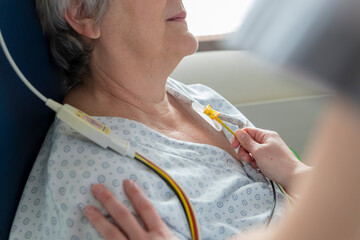
Anti-arrhythmic Drugs Linked to Bradycardia in Patients With AF
A new study has highlighted the risks for syncope and bradycardia as potential side effects with anti-arrhythmic drugs when used for the treatment of atrial fibrillation (AF).
Researchers analyzed data on 674,303 patients with new-onset AF from Korean National Health Insurance Services and found more than a threefold increased risk for syncope and pacemaker implantation in patients who were prescribed anti-arrhythmic drugs compared with those who were not prescribed such drugs, an observation which remained in a propensity-matched subgroup. The risk appeared to be greater in older patients and women.
The study is published in the March 19 issue of the Journal of the American College of Cardiology.
The authors, led by Yun Gi Kim, MD, Korea University College of Medicine, Seoul, South Korea, said that precise evaluation of the risk for syncope and bradycardia should be undertaken before prescribing anti-arrhythmic drugs for AF.
Coauthor of an accompanying editorial, Sanjay Dixit, MD, Hospital of the University of Pennsylvania, Philadelphia, Pennsylvania, told theheart.org | Medscape Cardiology that these new data should make clinicians more cautious in prescribing anti-arrhythmic drugs in AF, especially in older patients and women.
"This association of bradycardia with anti-arrhythmic drugs is not in itself a new observation," Dixit explained. "Most of the studies with anti-arrhythmic drugs in AF have shown an association with bradyarrhythmia events, but this adverse effect has not so far attracted much attention as the overall incidence is believed to be low and the studies were designed to look primarily at arrhythmia outcomes and mortality."
He said the important thing about this paper is that it sets out to look specifically at the risk for bradyarrhythmias and syncope with these drugs.
"While this study suggests that bradyarrhythmia occurs relatively infrequently — in only about 1.5% of patients — it was higher in patients on anti-arrhythmic drugs. So, it is important to recognize that if we treat more patients with these drugs, we will run into these issues."
The study authors used the Korean insurance database to screen all new-onset AF diagnoses that occurred from 2013 to 2019 and identified patients who were prescribed anti-arrhythmic drugs within 1 year of AF diagnosis.
They found a total of 770,977 new-onset AF cases, 142,141 of whom were prescribed anti-arrhythmic drugs. After multivariate adjustment, the use of anti-arrhythmic drugs was associated with a 3.5 times increased risk for pacemaker implantation or syncope, a twofold increased risk for syncope and a fivefold increased risk for pacemaker implantation.
Propensity score-matched analysis revealed similar results, demonstrating a significant association between anti-arrhythmic drug use and the risk for pacemaker implantation or syncope. This association was consistent across various subgroups. Women were more susceptible to adverse effects of anti-arrhythmic drugs than men.
The editorialists point out that the risk for bradyarrhythmia persisted for more than 2 years, raising the question of whether patients with AF on long-term anti-arrhythmic drugs who are at a higher risk of developing bradyarrhythmias may benefit from extended monitoring by insertable cardiac monitors.
Dixit noted several limitations of the study, including the inclusion of an exclusively Korean population, raising questions on generalizability; and because the findings were based on a claims database, detailed patient information was not available, so it was not possible to rule out bias.
He also said the results needed to be considered in the context of the overall effectiveness of anti-arrhythmic drugs in AF, which are used as part of a rhythm control strategy.
The landmark AFFIRM trial, reported in 2002, showed a trend toward higher overall mortality in patients randomized to rhythm (mostly with anti-arrhythmic drugs) vs rate control. But the more recent EAST-AFNET 4 trial, conducted in the era of contemporary clinical practice, showed an improvement in outcomes with rhythm control, with anti-arrhythmic drugs predominantly, although catheter ablation was also used, early after AF diagnosis.
"This is driving a lot of our current practices in managing AF — with an emphasis now on intervening early on to try to restore and maintain sinus rhythm," Dixit said. However, he noted that in studies comparing different options for rhythm control, catheter ablation was the more effective therapy.
"The various side effects of anti-arrhythmic drugs, including those highlighted in this study, make a strong case for using catheter ablation therapy early and more often to achieve rhythm control in patients with AF. The most recent update of the guidelines for the diagnosis and management of AF would support this practice," the editorialists concluded.
This work was supported by a grant from Korea University, a grant from Korea University Anam Hospital, Seoul, Republic of Korea, and in part by a National Research Foundation of Korea grant funded by the Korean government. The authors and editorialists reported no relevant disclosures.
Article from Medscape Nurses.
------------------------------------------------------------------------------------------------
To learn more about heart disease and prevention and to earn cardiac related CE hours, Pedagogy offers the following courses:
- Broken Heart Syndrome: Clinical Manifestations, Diagnosis, and Treatment
- Cardiovascular Assessment in the Elderly
- Critical Thinking in Cardiac Assessment
- ECG Interpretation: Basic Rhythms
- EKG Recognition
- Post-Cardiac Arrest Care in the ICU
- Women and Heart Disease
Pedagogy's courses are available for purchase by the individual or facility. For individuals, register with us to create your username and password, click on the course title of interest and then click the Purchase button. For a complete listing of all our online continuing education courses, including the largest selection of infusion continuing education courses offered online, click here!
For organizations that would like to purchase education for their entire staff, email sales@pedagogyeducation.com and let us know the course(s) of interest and how many staff members you need to provide education for, and we will be happy to send you a price quote.
